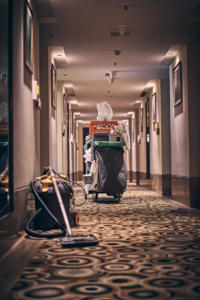Over the past few weeks, we have had the pleasure of speaking with clients from all over the globe – getting temperature checks on where things stand with their businesses, what trends they’re seeing in various unique locations, and understanding what the future might look like in a post-COVID world.
Certain trends have come to light – some exciting, some a bit concerning, many unsurprising.
Although safety, wellness, cleanliness, sanitation and compliance to brand standards and local ordinances are front-of-mind for all operators and owners, it is a non-negotiable for guests and customers. Perception is key moving forward. The guest should see staff sanitizing on a regular basis, making sure high touch areas are clean; the guest should see employees changing their gloves regularly. Seeing is believing, and guests require this assurance in order to once again feel comfortable dining out,  traveling, booking a massage, etc. Many of our hospitality clients are morbidly concerned that even when things begin to open up again, people won’t be able or willing to spend money. Make it an easier choice for them to do so.
traveling, booking a massage, etc. Many of our hospitality clients are morbidly concerned that even when things begin to open up again, people won’t be able or willing to spend money. Make it an easier choice for them to do so.
There is a lot of concern amongst our clients regarding travel – if and when it will begin again, what kind of reduction we will see, and what does travel in the future even look like. Will the readily accessible nature and newfound familiarity of virtual conference calls and meetings make business travel obsolete? Will companies forego offering incentive trips? Will families opt out of leisure travel based on health concerns? We’ve certainly come across an influx of cancellations of catering and group events (weddings, conferences, etc.). Businesses will need to find an alternative way to make up this revenue.
For restaurants, we are seeing curbside pick-up, online ordering and delivery surging, and most operators do not see this going anywhere anytime soon. If anything, predictions are optimistic as to what kind of ancillary – or even primary – revenue this could provide. There are some challenges with this service, however. Packaging needs to be tight so nothing spills during transit; the quality and temperature of food cannot waiver; the staff must abide by all safety and sanitation requirements; and there are unique challenges for restaurants based on location (restaurants in a shopping center, restaurants not situated on the first floor, city locations with limited parking or loading zones, etc.).
An interesting restaurant trend along the lines of pick-up and delivery is the rise of very high-end, at-home meals from local restaurants. Three Michelin-starred Alinea has been offering this in Chicago, along with many other steakhouses and critically acclaimed restaurants all over the country. Although the price point is higher than your regular take-out, it’s substantially lower than it would be to dine at the restaurant, especially if people are wallet conscious coming out of this crisis. The meals come with very detailed instructions for reheating so the quality is precise and on par with what you’d receive if dining in.
A major concern for restaurants is having to operate at a reduced capacity, and whether they will be able to afford to do so, especially given increased costs associated with safety and sanitation regulations. Risk mitigation will be more important than ever.
Coyle has stayed ahead of the curve when it comes to gauging how operational and safety/wellness protocols will change in the coming months and years. The most pressing concern for all of our clients is: how can we provide high touch service in a no-touch world? Only time will tell.
And we will stay on top of it every step of the way.













